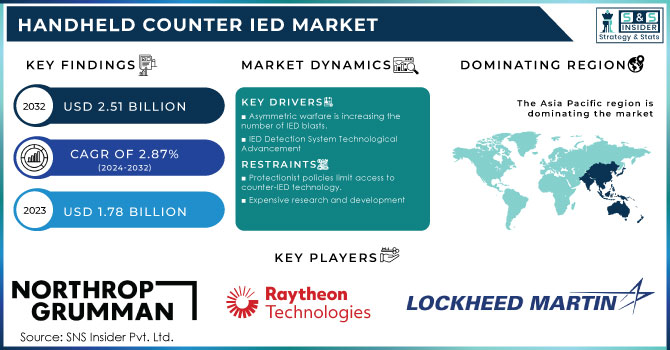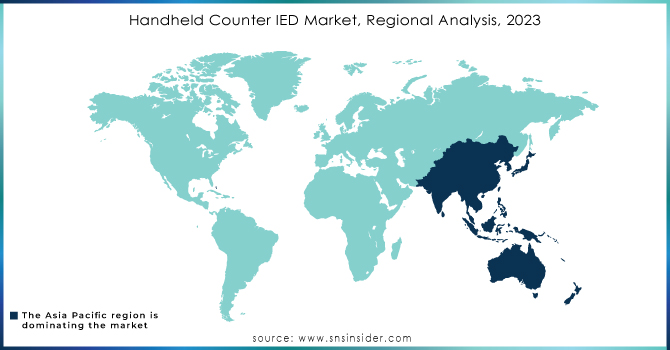Handheld Counter IED Market Report Scope & Overview:
The Handheld Counter IED Market Size was valued at USD 1.78 billion in 2023 and is expected to reach USD 2.51 billion by 2032 with and emerging CAGR of 2.87% over the forecast period 2024-2032.

To get more information on Handheld Counter IED Market - Request Free Sample Report
Handheld counter-improvised explosive devices (IEDs) are detection and countermeasure systems primarily utilised by military and law enforcement authorities. These gadgets are held in the user's hand and primarily comprise technology such as ground-penetrating radar.
The global market for handheld counter IEDs is quickly expanding. Increased military investment, growing terrorist threats, and an emphasis on counter-operations are driving expansion. The increased usage of countermeasure technologies, on the other hand, may stymie market expansion.
MARKET DYNAMICS
KEY DRIVERS
-
Asymmetric warfare is increasing the number of IED blasts.
-
IED Detection System Technological Advancement
RESTRAINTS
-
Protectionist policies limit access to counter-IED technology.
-
Expensive research and development
OPPORTUNITIES
-
Emerging Market Demand
-
Demand from Homeland Security Agencies is Growing
CHALLENGES
-
Constant system upgrade is a big problem for companies working in the counter-IED market.
-
To counter IEDs, continuous R&D and investment in varied technologies are essential.
IMPACT OF COVID-19
The emergence of the unique COVID-19 epidemic is expected to have a short-term impact on the worldwide counter-IED market's overall growth. Trade and transportation restrictions are anticipated to be a major impediment to the procurement of raw materials needed to create counter-IED kits and solutions. Furthermore, as governments throughout the world continue to prioritise the fight against emerging coronaviruses, demand for counter-IED technologies may see a modest dip, particularly in 2020. However, innovations and research activities are expected to continue at a steady pace in 2020, resulting in the introduction of new concepts and IED countermeasures in the next years.
The military sector is projected to lead the counter-IED market among end users. Militaries from various countries throughout the world are heavily involved in combating insurgents, terrorists, and other non-state actors who employ improvised explosive devices as a primary instrument to cause increased damage to public and private property and casualties. As a result, militaries from many countries employ various forms of counter-IED weapons to combat the risks posed by these improvised explosive devices.
The counter-IED market's airborne mounted deployment category is expected to develop at the fastest CAGR during the projected period. The expansion of this market segment can be ascribed to the growing usage of airborne platforms by military from various countries to identify improvised explosive devices hidden underground. These platforms are outfitted with various sensors and payloads to detect improvised explosive devices at various ranges.
The global defence sector is continuing to reduce diverse IED risks by focusing on three parameters: detection, protection, and neutralisation. The significant improvement in military vehicle development is largely driven by the increased need to confront the future IED threat. Traditional defence vehicles increasingly gave place to customised infantry fighting vehicles and armoured personnel carriers as a result of adverse ground circumstances and uncertainty. The evolving nature of IEDs deployed by terrorist organisations has prompted counter-IED market participants to maintain a consistent focus on innovation and the deployment of effective counter-IED measures and solutions.
KEY MARKET SEGMENTATION
By Deployment
-
Vehicle mounted
-
Ship mounted
-
Airborne mounted
-
Handheld
By Capability
-
Detection
-
Countermeasure
By End User
-
Military
-
Homeland Security
By Airborne Mounted
-
Aircraft
-
Aerostat
-
UAV
REGIONAL ANALYSIS:
The counter-IED market in Asia Pacific is expected to develop at the fastest CAGR during the forecast period, followed by the counter-IED market in the Middle East and Africa. The increased usage of improvised explosive devices in terror attacks, as well as rising defence spending in Asia Pacific's emerging economies, are likely to fuel the growth of the Asia Pacific counter-IED market during the forecast period. Several Asian Pacific countries are replacing traditional IED detection techniques with sophisticated ground penetrating radars, laser detectors, and high-resolution optical detection systems.

Need any customization research on Handheld Counter IED Market - Enquiry Now
REGIONAL COVERAGE:
-
North America
-
USA
-
Canada
-
Mexico
-
-
Europe
-
Germany
-
UK
-
France
-
Italy
-
Spain
-
The Netherlands
-
Rest of Europe
-
-
Asia-Pacific
-
Japan
-
south Korea
-
China
-
India
-
Australia
-
Rest of Asia-Pacific
-
-
The Middle East & Africa
-
Israel
-
UAE
-
South Africa
-
Rest of Middle East & Africa
-
-
Latin America
-
Brazil
-
Argentina
-
Rest of Latin America
-
KEY PLAYERS
The Major Players are Lockheed Martin Corporation, Raytheon Company, Northrop Grumman Corporation, Thales Group, General Dynamics Corporation, Elbit Systems Ltd, L3 Harris Corporation, Chemring Group, L3 Technologies Inc., Allen-Vanguard Corporation, and other players
| Report Attributes | Details |
|---|---|
| Market Size in 2022 | US$ 1.78 Billion |
| Market Size by 2030 | US$ 2.51 Billion |
| CAGR | CAGR of 2.87% From 2024 to 2032 |
| Base Year | 2023 |
| Forecast Period | 2024-2032 |
| Historical Data | 2020-2022 |
| Report Scope & Coverage | Market Size, Segments Analysis, Competitive Landscape, Regional Analysis, DROC & SWOT Analysis, Forecast Outlook |
| Key Segments | • By Deployment (Vehicle mounted, Ship mounted, Airborne mounted, Handheld) • By Capability (Detection (ADS, MIDS), and Countermeasure (Jammer, Neutralization)) • By End User (Military, Homeland Security) • By Airborne Mounted [Aircraft, Aerostat, and UAV] |
| Regional Analysis/Coverage | North America (USA, Canada, Mexico), Europe (Germany, UK, France, Italy, Spain, Netherlands, Rest of Europe), Asia-Pacific (Japan, South Korea, China, India, Australia, Rest of Asia-Pacific), The Middle East & Africa (Israel, UAE, South Africa, Rest of Middle East & Africa), Latin America (Brazil, Argentina, Rest of Latin America) |
| Company Profiles | Lockheed Martin Corporation, Raytheon Company, Northrop Grumman Corporation, Thales Group, General Dynamics Corporation, Elbit Systems Ltd, Harris Corporation, Chemring Group, L3 Technologies Inc., Allen-Vanguard Corporation |
| KEY DRIVERS | • Asymmetric warfare is increasing the number of IED blasts. • IED Detection System Technological Advancement |
| Restraints | • Protectionist policies limit access to counter-IED technology. • Expensive research and development |

